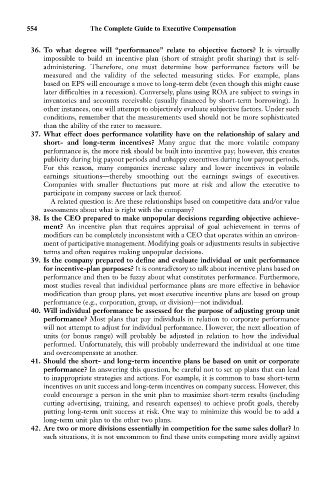Page 568 - Bruce Ellig - The Complete Guide to Executive Compensation (2007)
P. 568
554 The Complete Guide to Executive Compensation
36. To what degree will “performance” relate to objective factors? It is virtually
impossible to build an incentive plan (short of straight profit sharing) that is self-
administering. Therefore, one must determine how performance factors will be
measured and the validity of the selected measuring sticks. For example, plans
based on EPS will encourage a move to long-term debt (even though this might cause
later difficulties in a recession). Conversely, plans using ROA are subject to swings in
inventories and accounts receivable (usually financed by short-term borrowing). In
other instances, one will attempt to objectively evaluate subjective factors. Under such
conditions, remember that the measurements used should not be more sophisticated
than the ability of the rater to measure.
37. What effect does performance volatility have on the relationship of salary and
short- and long-term incentives? Many argue that the more volatile company
performance is, the more risk should be built into incentive pay; however, this creates
publicity during big payout periods and unhappy executives during low payout periods.
For this reason, many companies increase salary and lower incentives in volatile
earnings situations—thereby smoothing out the earnings swings of executives.
Companies with smaller fluctuations put more at risk and allow the executive to
participate in company success or lack thereof.
A related question is: Are these relationships based on competitive data and/or value
assessments about what is right with the company?
38. Is the CEO prepared to make unpopular decisions regarding objective achieve-
ment? An incentive plan that requires appraisal of goal achievement in terms of
modifiers can be completely inconsistent with a CEO that operates within an environ-
ment of participative management. Modifying goals or adjustments results in subjective
terms and often requires making unpopular decisions.
39. Is the company prepared to define and evaluate individual or unit performance
for incentive-plan purposes? It is contradictory to talk about incentive plans based on
performance and then to be fuzzy about what constitutes performance. Furthermore,
most studies reveal that individual performance plans are more effective in behavior
modification than group plans, yet most executive incentive plans are based on group
performance (e.g., corporation, group, or division)—not individual.
40. Will individual performance be assessed for the purpose of adjusting group unit
performance? Most plans that pay individuals in relation to corporate performance
will not attempt to adjust for individual performance. However, the next allocation of
units (or bonus range) will probably be adjusted in relation to how the individual
performed. Unfortunately, this will probably underreward the individual at one time
and overcompensate at another.
41. Should the short- and long-term incentive plans be based on unit or corporate
performance? In answering this question, be careful not to set up plans that can lead
to inappropriate strategies and actions. For example, it is common to base short-term
incentives on unit success and long-term incentives on company success. However, this
could encourage a person in the unit plan to maximize short-term results (including
cutting advertising, training, and research expenses) to achieve profit goals, thereby
putting long-term unit success at risk. One way to minimize this would be to add a
long-term unit plan to the other two plans.
42. Are two or more divisions essentially in competition for the same sales dollar? In
such situations, it is not uncommon to find these units competing more avidly against

